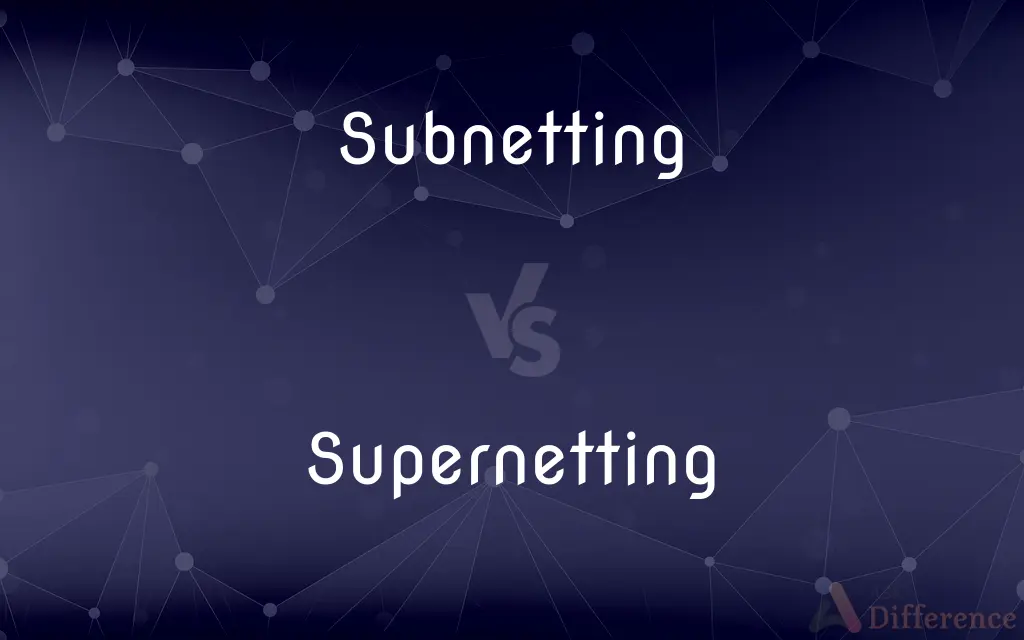Subnetting vs. Supernetting — What's the Difference?
By Tayyaba Rehman — Published on January 12, 2024
Subnetting divides a network into smaller, efficient subnetworks, while Supernetting combines multiple networks into a larger one for simplified management.

Difference Between Subnetting and Supernetting
Table of Contents
ADVERTISEMENT
Key Differences
Subnetting is the process of dividing a larger network into smaller, more manageable subnetworks. This improves network performance and security. In contrast, Supernetting is the practice of combining multiple smaller networks into a single, larger network, often to simplify IP address management.
Subnetting allows for efficient use of IP addresses within a network by minimizing waste. Each subnet can be tailored to the size required. On the other hand, Supernetting, also known as route aggregation, reduces the number of routing entries in a routing table, thereby simplifying network administration.
Subnetting is commonly used in medium to large networks to break down a large network space into smaller, controllable segments. It provides better local network control and reduces network traffic. Whereas, Supernetting is typically used in scenarios where multiple networks need to be connected, like in ISP (Internet Service Provider) networks, for effective routing.
Subnetting requires careful planning to allocate IP addresses efficiently and avoid overlap. It often involves subnet masks to define the network and host portions of an IP address. In contrast, Supernetting involves the use of CIDR (Classless Inter-Domain Routing) to combine networks, which also involves modifying the subnet mask to represent the larger network.
Subnetting is beneficial for isolating network segments, which can be crucial for security and performance optimization. In contrast, Supernetting is advantageous for reducing the complexity of network routing tables, making network management more straightforward at a larger scale.
ADVERTISEMENT
Comparison Chart
Primary Purpose
Divides a larger network into smaller subnets
Combines smaller networks into a larger network
Network Management
Creates more networks, enhances control
Reduces number of networks, simplifies management
IP Address Utilization
Efficient use of IP addresses in a network
Aggregates multiple networks for simplified IPs
Typical Use Case
Used in medium to large organizations
Used by ISPs to manage routing efficiently
Effect on Routing
Increases routing complexity
Decreases routing complexity
Compare with Definitions
Subnetting
It helps in enhancing network performance and security.
Subnetting our network resulted in reduced congestion and increased security.
Supernetting
It is used to reduce the complexity of routing tables.
Supernetting helped in minimizing the routing entries in our ISP network.
Subnetting
Subnetting is used for organizing a network into manageable sections.
Our network administrator implemented subnetting to manage traffic effectively.
Supernetting
Supernetting involves the use of CIDR for larger network aggregation.
We implemented CIDR techniques for effective supernetting.
Subnetting
Subnetting involves using a subnet mask to divide the network.
We used a specific subnet mask to create subnets within our network.
Supernetting
It simplifies IP address management across multiple networks.
Our network team used supernetting to handle IP addresses more efficiently.
Subnetting
It allows more efficient use of IP addresses within a network.
Subnetting helped us avoid IP address exhaustion in different departments.
Supernetting
Supernetting combines multiple networks into a larger one.
We used supernetting to simplify the management of our regional offices' networks.
Subnetting
Subnetting is dividing a network into smaller logical subdivisions.
By subnetting our company's network, we improved its efficiency and security.
Supernetting
Supernetting is beneficial for ISPs for efficient routing.
As an ISP, we use supernetting to manage our diverse customer base.
Common Curiosities
What are the advantages of supernetting?
Supernetting simplifies routing and IP address management, especially for ISPs.
Can subnetting and supernetting be used together?
Yes, they can be used together for efficient network design and management.
Is supernetting common in small networks?
No, it's more common in larger networks or ISPs for efficient routing.
Can subnetting help in traffic management?
Yes, it helps in managing and controlling network traffic efficiently.
What is a subnet mask in subnetting?
A subnet mask is used in subnetting to divide the IP address into network and host parts.
What is subnetting in networking?
Subnetting is the process of dividing a larger IP network into smaller, manageable subnetworks.
How does supernetting differ from subnetting?
Supernetting combines multiple smaller IP networks into a larger one, whereas subnetting breaks down a larger network.
What tools are used for subnetting?
Subnet calculators and IP management software are commonly used for subnetting.
How does CIDR relate to supernetting?
CIDR (Classless Inter-Domain Routing) is a method used in supernetting for combining IP networks.
Why is subnetting important?
Subnetting improves network performance, security, and efficiency in IP address allocation.
Does supernetting reduce routing complexity?
Yes, it reduces routing table complexity and improves routing efficiency.
Can any network benefit from supernetting?
Supernetting is more beneficial for larger networks or ISPs, not small networks.
How does subnetting affect network security?
Subnetting enhances security by isolating network segments, reducing breach risks.
Is knowledge of subnetting essential for network professionals?
Yes, understanding subnetting is crucial for efficient network design and management.
Are there any downsides to subnetting?
It can increase the complexity of network configuration and management.
Share Your Discovery

Previous Comparison
HP Pavilion vs. Acer Aspire
Next Comparison
Active Immunity vs. Passive ImmunityAuthor Spotlight
Written by
Tayyaba RehmanTayyaba Rehman is a distinguished writer, currently serving as a primary contributor to askdifference.com. As a researcher in semantics and etymology, Tayyaba's passion for the complexity of languages and their distinctions has found a perfect home on the platform. Tayyaba delves into the intricacies of language, distinguishing between commonly confused words and phrases, thereby providing clarity for readers worldwide.
















































